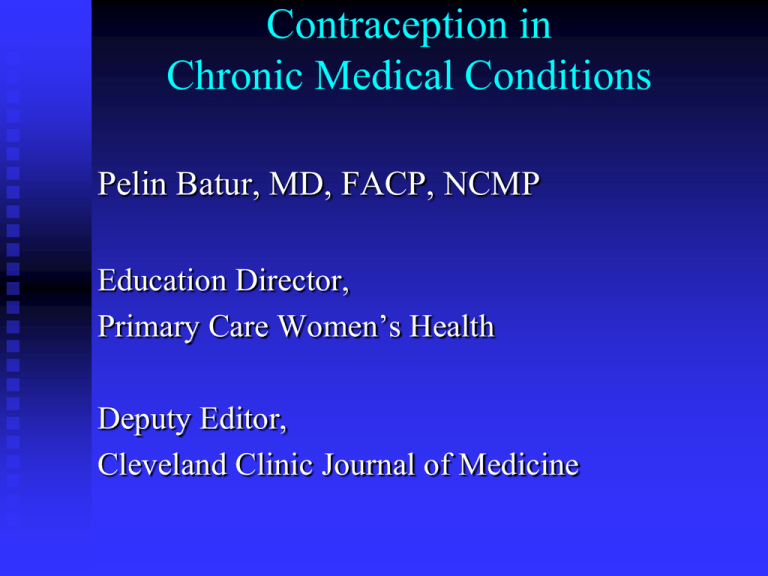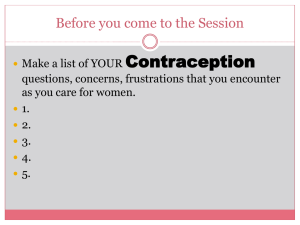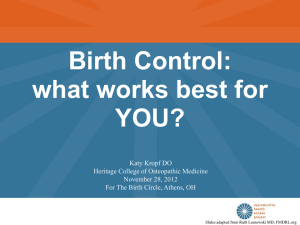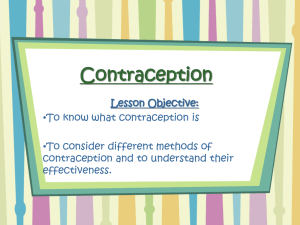Contraception in Chronic Medical Conditions
advertisement

Contraception in Chronic Medical Conditions Pelin Batur, MD, FACP, NCMP Education Director, Primary Care Women’s Health Deputy Editor, Cleveland Clinic Journal of Medicine Why do I care? GYNs might need our help Help find answers to ‘annoying’ questions You are using the most teratogenic meds Might need info in your personal life! Why wouldn’t you use it!?? Some fun facts… 50% of pregnancies unintended 4/10 of these lead to abortion 54% of those who had abortions had used a contraceptive that month 1/3 US servicewomen can’t access before deployment Most effective methods discouraged or unavailable 41% hard time getting refills Finer et al. Contraception 2011; 84:478–485 Grindlay et al. Contraception 2013; 87:162-169 Conditions that may make unintended pregnancy an unacceptable health risk Breast cancer Complicated valvular heart disease Diabetes with vascular complications Endometrial or ovarian cancer Epilepsy Bariatric surgery within 2 years HIV/AIDS Ischemic heart disease Malignant liver tumors Peripartum cardiomyopathy Schistosomiasis with liver fibrosis Severe cirrhosis Sickle cell disease Solid organ transplant within 2 years Stroke SLE Thrombogenic mutations Tuberculosis Female Condom Diaphragm Sponge Cervical cap Long Acting Reversible Contraceptives (LARCs) The contraceptive CHOICE project Prospective study: what happens if cost is not an issue? LARCs chosen by 75% of women LARCs 20x more effective than CHC 2008-2010 abortions ↓ by 20.6% Teen birth-rate ↓ 6.3/1000 (national av is 34.3) Peipert JF et al. Obs Gynecol Oct 2012 Winner B, et al. NEJM May 2012 Contraception & Health Care Policy ACA Women’s Preventive Services: Contraception Health Plans must cover: FDA-approved contraception methods Sterilization Patient ed and counseling No deductibles and co-pays. Does it save us money? Cost of unintended pregnancy in the US = 4.6 billion/yr Including LARCs: If 10% of women age 20-29 changed to LARCs, savings $288 million/year Extending coverage to low income Americans for 5 yrs 72 prevented pregnancies per 1000 women Saves $489 per woman enrolled Doesn’t include cost of • Decreased productivity • Ob complications • Health of children • Undocumented immigrants Trussel et al. Contraception 2013; 87:154 Burlone et al. Contraception 2013; 87:143 Is there really an access issue? Counterfeit and illegal sales o Can buy contraception without rx o Facebook, Twitter, Slideshare, Flickr Liange B et al. Contraception 86 (2012): 551 Martinez G. Vital Health Stat 2011; 23:1 Is there really an access issue? Counterfeit and illegal sales o Health care providers buying from these sites! Liange B et al. Contraception 86 (2012): 551 Martinez G. Vital Health Stat 2011; 23:1 Intrauterine Contraception: IUD ParaGard Mirena Skyla Silver identifier Copper, 10 yrs No hormones 5 yrs 3 yrs Both with local progestin Progestin Only Contraception: _____________ Implanon Nexplanon Lasts 3 yrs 99% effective unless meds that induce liver enzymes 30-40% amenorrhea at 1 yr Arm pain and numbness in a Nexplanon user Implant Medial cutaneous nerve (forearm) Brown M et al. Contraception 2012; 86:591 Intrauterine Contraception: Essure Local anesthesia, 10 minutes Back-up method needed for first 3 months MRI Safety MR Safe Mirena Nexplanon MR Conditional Safe if scanner <3 T Essure Copper IUD Skyla MR Unsafe Progestin Only Contraception: Depo-Provera Failure rate 0.0-0.7% Side Effects: Menorrhagia, amenorrhea Weight gain (1-3 kg) Hypoestrogenic Higher insulin and FBS ↓ HDL Bone Health: Depo-Provera Black box warning: Osteopenia Studies on BMD mixed BMD at 5 yrs vs controls -5.38% in LS ( -3.13% 2 yrs after dc) -5.16% in TH ( -1.34%) -6.12% in FN ( -5.38%) Decline is more pronounced in first 2 yrs ACOG & WHO: Advantages of DMPA > risks Can continue for decades! Batur P, Joy S. Clinical Reviews of Bone and Mineral Metabolism; 3(2): 103-113, 2005 Bone Health: Depo-Provera Use of DMPA and incidence of bone fracture 312,395 women in UK, retrospectively followed 5 yrs Fx incidence in 1000 women: 9.1 (Depo) vs 7.3 (nonDepo) Incidence RR 1.23 (95% CI 1.16-1.130) Overall “message”: no significant increase DMPA cohort higher risk of fx at baseline Risk did not increase further after DMPA initiated Longer term users had lower fx risk than short term No excess risk of axial fx (hip, pelvis, vertebral) Lanza L, et al. Obs Gynecol March 2013; 121 (3), 593 Is a DXA scan needed? Use clinical judgment, depends on: Length of use Risk factors Insurance coverage Try dx code 256.39 Progestin only pill "mini-pill” For those who cannot tolerate estrogen CAD, VTE, stroke Migraine w/ aura DM w/ vascular complication <6 wks postpartum Uncontrolled hypertension Main use in lactating women Higher rates of breakthrough bleeding Lower contraceptive efficacy Back up method for 2 days if > 3hrs late w/ dose Combined Oral Contraceptives (COC) Have been used ~ 50 years in the US Most popular contraceptive choice along with sterilization NuvaRing Ortho Evra COC Metabolism Contraceptive effectiveness may be reduced when co-administered with: rifampin anticonvulsants (phenytoin, carbamazepine, topiramate, barbiturates) anti-HIV protease inhibitors non-prescription/herbal products ( St. John's wort) COC Metabolism EE increased when co-administered with: atorvastatin (Lipitor), ↑20% rosuvastatin ok erythro/clarithromycin acetaminophen ascorbic acid itraconazole, ketoconazole grapefruit juice Combined Oral Contraceptives: Progestin Formulations First Generation: Seconds Generation: norgestrel levonorgestrel Third Generation: norethindrone ethynodiol diacetate norgestimate desogestrel (RR VTE 1.7-19x) Fourth Generation: drospirenone (RR VTE 0.9-3x) dienogest Why are they so mean to Yasmin/Yaz? Letter to patients from Aetna… Did you suffer any cardiovascular - or gallbladder - related injury or injuries during or after [the period when you used Yaz, Yasmin, or Ocella]? Have you pursued, are you pursuing, or do you intend to pursue a personal injury claim related to your use of Yaz, Yasmin, or Ocella? Have you hired or do you plan to hire an attorney to represent you in this claim? The aftermath… ~12,000 lawsuits to Bayer settled 1,977 cases for $402.6 million, for an average of $212,000 per case, while setting aside $610.5 million to settle the others Source: Bloomberg.com What does the data really show? Summary of VTE: absolute risks Condition Rate of VTE (per 10,000 women per year) Reproductive Aged (baseline-no pill) 1-5 Pill users 3-10 (*rates vary by progestins) Pregnancy 10-29 Postpartum 65-400 COC Risks Coronary artery disease Hypertension Stroke Breast cancer Lung cancer COC Risks Coronary artery disease Hypertension Stroke Fertil Steril 2006; 85(5):1425 ? Protective effect Breast cancer Lung cancer NEJM 2012; 366:2257 30-40 mcg EE RR ↑ 1.3-2.3 20 mcg EE RR ↑ 0.0-1.6 Ortho Evra RR 0.0 Nuvaring ↑ 2.1 COC Risks Coronary artery disease Fertil Steril 2006; 85(5):1425 ? Protective effect NEJM 2012; 366:2257 30-40 mcg EE RR ↑ 1.3-2.3 20 mcg EE RR ↑ 0.0-1.6 Ortho Evra RR 0.0 Nuvaring ↑ 2.1 COC Risks Coronary artery disease Hypertension Stroke Breast cancer Lung cancer COC Risks Coronary artery disease Hypertension Stroke 2009; 40(4):1050 Stroke No increased risk Breast cancer NEJM 2012; 366:2257 Lung cancer 30-40 mcg EE RR ↑ 1.5-2.2 20 mcg EE RR ↑ 0.9-1.7 Ortho Evra ↑ 3.2 Nuvaring ↑ 2.5 ACOG Risk is small but catastrophic COC Risks Stroke Stroke 2009; 40(4):1050 No increased risk NEJM 2012; 366:2257 30-40 mcg EE RR ↑ 1.5-2.2 20 mcg EE RR ↑ 0.9-1.7 Ortho Evra ↑ 3.2 Nuvaring ↑ 2.5 ACOG Risk is small but catastrophic COC Risks Coronary artery disease Hypertension No ↑ risk Stroke •Contraception 2012; 85: p342 •NEJM 1986; 315:p405 Breast cancer •JAMA 2000;284: p1791 •NEJM 2002; 346: p2025 Lung cancer ↑ risk •Lancet 1996; 347: p1713 •Br J Cancer 2003;88: p50 •Can Epid Prev 2010; 19: p2496 •Mayo Clin Proc 2006;81: p1287 COC Risks Breast cancer BRCA carriers: •↓ovarian cancer RR 0.50 (CI 0.33-0.75) •No association with breast cancer • Formulations before 1975 ↑risk • RR 1.47 (1.06-2.04) Eur J Cancer 2010: 46(12): 2275 COC Risks Coronary artery disease Hypertension Stroke Breast cancer Lung cancer CDC: US medical eligibility criteria for contraceptive use, 2010 1 = condition with no restriction 2 = condition where advantage > risk 3 = condition where advantage < risk 4 = condition represents unacceptable health risk if that method is used http://www.cdc.gov/mmwr/preview/mmwrhtml/rr59e0528a13.htm Contraception for diabetics Don’t worry about: gestational diabetes worsening control of DM Special Considerations: Bariatric Surgery Gastric bypass COC category 3 All other methods category 1 Restrictive (lap band) All category 1 Headache… Seizure Disorder Decreased contraceptive efficacy Use doses >50 mcg EE lamotrigine (Lamictal) Barbiturates, carbamazepine, oxcarbazepine, felbamate, topiramate levels reduced Levetiracetam, valproic ok COCs decrease the lamotrigine levels by 50% Toxic levels in placebo week DMPA, IUD Cochrane Rev Abstract 2007 Sickle cell disease No proof COC contributes to extra VTE risk No studies looking at this directly No effect on number of crisis Fair-poor quality studies In CR only 1 trial met criteria to be included 25 patients- Depo-Provera vs placebo During DMPA use, less sickle episodes • OR 0.23 (95% CI 0.05-1.02) Cochrane Rev Abstract 2007 Contraception 2012; 85: 527 Systemic Lupus Erythematosus Low likelihood of significant flare w/COC* Thrombosis risk not increased Excluded those with mod-high ab levels Caution w/ drospirenone, DMPA Severe thrombocytopenia: avoid ParaGard & DMPA Use of immunosuppressants does not affect choice *Petri M, et al. N Engl J Med. 2005;353:2550-2559 . *Sanchez-Guerrero J et al. N Engl J Med. 2005;353:2539-2950 . Rheumatoid arthritis COC has no negative outcomes on RA COC use > 5 yrs, RR of severe dz 0.1 (95% CI 0.01-0.6) DMARDs: methotrexate & leflunomide are pregnancy category X Stop MTX 3 months & leflunomide 2 yrs prior to conception Ann Rheum Dis. 1996 February; 55(2): 94–98. J of Rheumatology. Vol 31: Supplement 69, March 2004 Organ Transplant Amenorrhea/infertility common with hepato- renal disease 1/20 transplant patients of childbearing get pregnant National transplantation pregnancy registry: Live birth rate 50-86% Medicare: Live birth rate 55% Post transplant pregnancy 33/1000 women Estimates don’t include abortions Organ Transplant Pregnancy risks post transplant: Graft rejection Pregnancy complications Most antirejection agents are pregnancy class D Contraception should be discussed prior to transplant Women should wait 18-24 months before pregnancy IUD, hormonal options are category 2 • Unless graft failure, rejection, allograft vasculopathy – COC category 4 – IUD category 3 – Depo, POP category 2 HIV CDC update 6/2012: All hormonal contraception may be used in those with HIV ? Increased risk of HIV acquisition Depo HR 2.04 (CI 1.04-2.05) COC HR 1.8 (CI 0.55-5.82) MMWR 2012; 61(24):449 Lancet Inf Dis 2012; 12(1): 19 ? Increased HIV acquisition Should we shift away from DMPA to condoms or pills? 600 additional unwanted births per 100 HIV infections averted If no protection: 5400 unwanted births Jain AK. Contraception 86 (2012): 645 CHC Category 1 Medical Conditions Family history of breast cancer Cirrhosis Endometrial cancer/hyperplasia Ovarian cancer HIV Malaria Viral hepatitis Varicose veins TB Category 1 Medical Conditions assuming not… Cirrhosis not severe, decompensated HIV watch drug interactions Viral hepatitis not acute or flare CHC Category 2 Medical Conditions Cervical cancer DVT family hx (1st degree) Superficial thrombophlebitis Gallstones (asymptomatic) Pregnancy related cholestasis HTN during pregnancy FNH liver IBD Valvular heart disease Category 2 Medical Conditions assuming not… Preg related cholestasis not COC related IBD not extensive, dehydration, vitamin deficiency, surgery, steroid use, immobilization Valvular heart dz not complicated (pulm htn, htn, afib, SBE) CHC Category 3 Medical Conditions VTE/PE Breast cancer Peripartum cardiomyopathy >6 months CHC Category 3 Medical Conditions assuming: VTE/PE anticoagulation for 3 months, low risk for recurrence Breast cancer disease free for 5 years Peripartum cardiomyopathy >6 months & normal or mildly impaired cardiac function Emergency Contraception Method Dose Efficacy high dose estrogen 5 mg EE qd x 5 75-80% estrogen + progestin 100 ug EE + 0.5 mg levonorgestrel po q12 hr x 2 56-89 % levonorgestrel (Plan B) 0.75 mg q12 x 2 (Plan B One-Step) 1.5 mg x1 60-94 % ulipristal (ella™) 30 mg ~98.6% copper IUD Insert within 5 days 99% Emergency Contraception Method Dose Efficacy levonorgestrel (Plan B) 0.75 mg q12 x 2 (Plan B One-Step) 1.5 mg x1 60-94 % ulipristal (ella™) 30 mg ~98.6% Emergency Contraception Method Dose EC Hotline: 1-888-NOT-2LATE Efficacy Thank you! baturp@ccf.org






